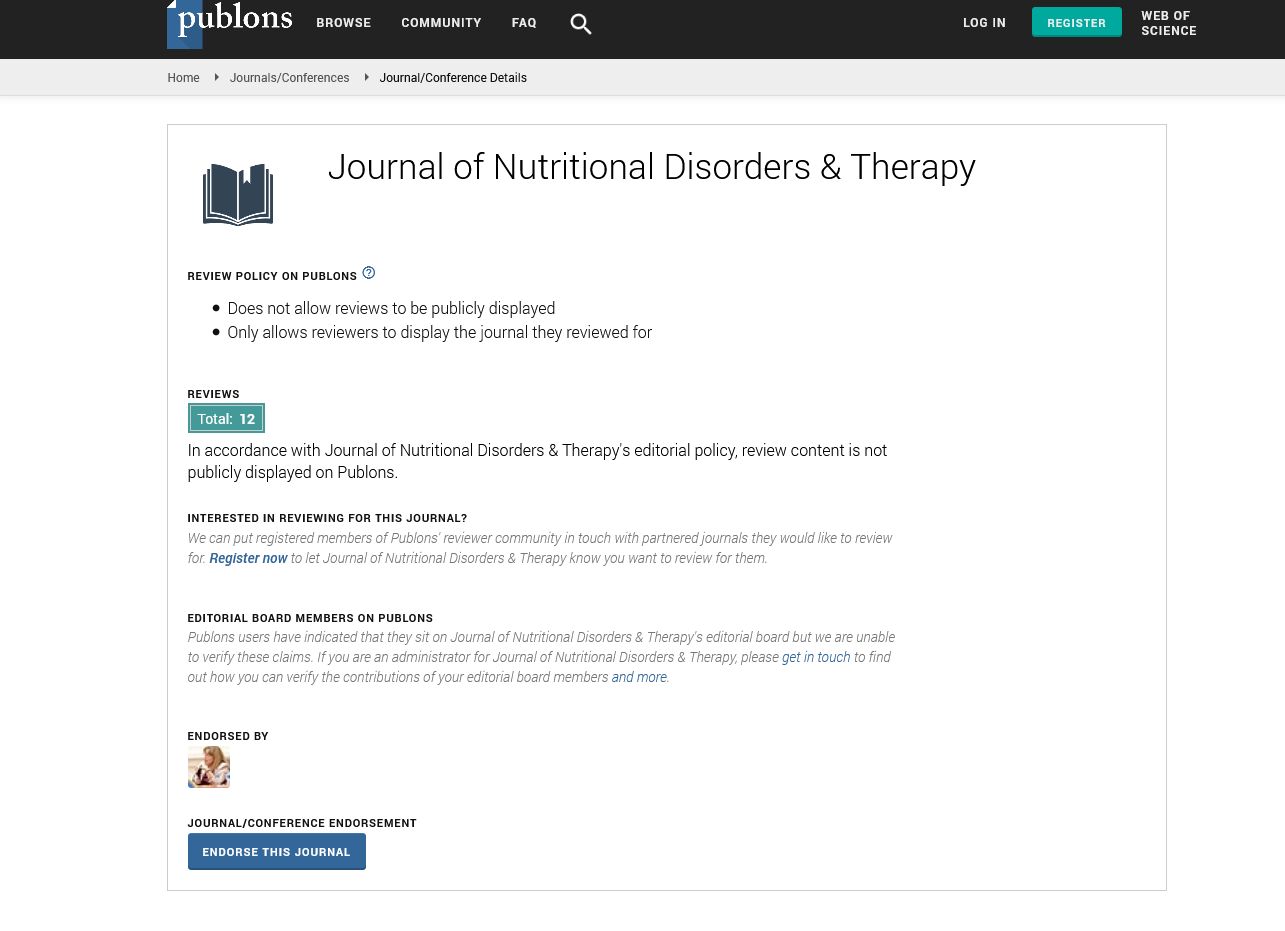Indexed In
- Open J Gate
- Genamics JournalSeek
- Academic Keys
- JournalTOCs
- Ulrich's Periodicals Directory
- RefSeek
- Hamdard University
- EBSCO A-Z
- OCLC- WorldCat
- Publons
- Geneva Foundation for Medical Education and Research
- Euro Pub
Useful Links
Share This Page
Journal Flyer

Open Access Journals
- Agri and Aquaculture
- Biochemistry
- Bioinformatics & Systems Biology
- Business & Management
- Chemistry
- Clinical Sciences
- Engineering
- Food & Nutrition
- General Science
- Genetics & Molecular Biology
- Immunology & Microbiology
- Medical Sciences
- Neuroscience & Psychology
- Nursing & Health Care
- Pharmaceutical Sciences
Opinion Article - (2024) Volume 14, Issue 4
Evaluating the Role of CD38 as a Diagnostic Marker for Rickets
Yan Zhang*Received: 22-Nov-2024, Manuscript No. JNDT-24-27631; Editor assigned: 25-Nov-2024, Pre QC No. JNDT-24-27631(PQ); Reviewed: 09-Dec-2024, QC No. JNDT-24-27631; Revised: 16-Dec-2024, Manuscript No. JNDT-24-27631(R); Published: 23-Dec-2024, DOI: 10.35248/2161-0509.24.14.311
Description
Rickets, a metabolic bone disorder primarily associated with vitamin D deficiency, remains a significant public health issue, particularly in regions where malnutrition and limited sunlight exposure are prevalent. Characterized by impaired bone mineralization, rickets often manifests in children as skeletal deformities, growth retardation and in severe cases, hypocalcemia-induced complications. Despite advancements in our understanding of rickets, its early diagnosis continues to pose challenges. Biomarkers have played a pivotal role in advancing diagnostic precision and recent attention has turned to CD38, a multifunctional ectoenzyme with potential diagnostic applications in metabolic and inflammatory disorders.
CD38 is a transmembrane glycoprotein expressed on various cell types, including immune cells, osteoblasts and osteoclasts. Its functions span calcium signaling, Nicotinamide Adenine Dinucleotide (NAD+) metabolism and immune modulation, processes that are intimately tied to bone metabolism and mineral homeostasis. Emerging evidence suggests that CD38 may be implicated in the pathophysiology of rickets, particularly in its interaction with calcium-phosphorus metabolism, vitamin D pathways and bone remodeling mechanisms. Understanding the role of CD38 in these processes could prepare for its utilization as a diagnostic biomarker for rickets, offering new avenues for early detection and targeted intervention.
Bone metabolism is a dynamic process involving the intereaction between osteoblast-mediated bone formation and osteoclast driven bone resorption. CD38 is known to influence both processes through its role in calcium signaling and NAD+ metabolism. Calcium is critical for the mineralization of bone matrix and disruptions in calcium homeostasis are a hallmark of rickets. CD38, by regulating intracellular calcium flux and signaling cascades, can modulate osteoblast and osteoclast activity, thereby influencing bone health.
Moreover, CD38’s role in NAD+ metabolism is of particular interest. NAD+ is a coenzyme essential for cellular energy metabolism and signaling. It also influences the activity of sirtuins, a family of NAD+-dependent enzymes that regulate bone remodeling. Reduced NAD+ levels, as observed in conditions of chronic inflammation or metabolic stress, can impair sirtuin activity, leading to dysregulated osteoclastogenesis and diminished bone mineralization. CD38, as a key regulator of NAD+ levels, may thus serve as an indirect marker of bone metabolic dysfunction in rickets.
Vitamin D is the cornerstone of calcium-phosphorus metabolism and its deficiency is a primary etiological factor in rickets. Recent studies have highlighted a potential link between CD38 expression and vitamin D signaling. Vitamin D modulates immune responses and CD38 is highly expressed on immune cells, including T cells and macrophages. This interaction may be relevant in rickets, where chronic inflammation is often a contributing factor.
Furthermore, vitamin D is involved in the regulation of osteoclast and osteoblast activity. Deficiencies in vitamin D impair the expression of genes critical for bone mineralization, such as those encoding alkaline phosphatase and osteocalcin. CD38, through its metabolic and signaling roles, may act as a mediator of these vitamin D-dependent pathways, amplifying its relevance as a potential biomarker for rickets.
Rickets is increasingly recognized as not merely a consequence of nutritional deficiencies but also a condition influenced by chronic inflammation. Pro-inflammatory cytokines, such as Tumor Necrosis Factor-Alpha (TNF-α) and Interleukin-6 (IL-6), are elevated in various forms of rickets, particularly in those associated with renal or genetic etiologies. CD38, known for its role in immune cell activation and cytokine signaling, may contribute to the inflammatory milieu observed in rickets.
Studies have shown that CD38 expression is upregulated in response to inflammatory stimuli and its enzymatic activity generates signaling molecules that modulate immune responses. This dual role of CD38 in inflammation and calcium signaling underscores its potential as a biomarker that reflects both metabolic and inflammatory dimensions of rickets. By measuring CD38 expression or activity levels, clinicians could gain insights into the severity and multifactorial nature of the disorder.
The diagnostic utility of CD38 in rickets lies in its multifaceted roles in bone metabolism, vitamin D pathways and immune regulation. Traditional diagnostic methods for rickets, including serum calcium, phosphorus, alkaline phosphatase and vitamin D levels, provide valuable but often incomplete insights. These markers may not always capture the underlying cellular and molecular dysfunctions contributing to rickets, particularly in its early stages or atypical presentations.
CD38 offers a complementary approach by serving as a molecular marker that connects metabolic and inflammatory processes. Its measurement, potentially through blood or bone marrow-derived samples, could enhance diagnostic precision. For instance, elevated CD38 levels may indicate heightened immune activity or metabolic stress, flagging early disruptions in bone health before overt clinical symptoms arise. Additionally, combining CD38 analysis with traditional biomarkers could improve risk stratification and guide personalized therapeutic interventions.
Conclusion
The evaluation of CD38 as a diagnostic marker for rickets represents an exciting frontier in the intersection of metabolic and immune research. By linking calcium signaling, NAD+ metabolism and inflammation, CD38 offers a unique lens through which to understand the multifactorial pathophysiology of rickets. Although more research is needed to validate its clinical utility, CD38 holds potential as a tool for early detection, risk assessment and tailored management of rickets. Integrating CD38 analysis into the diagnostic framework could ultimately improve outcomes for children affected by this debilitating condition, paving the way for a more nuanced and effective approach to bone health.
Citation: Zhang Y (2024). Evaluating the Role of CD38 as a Diagnostic Marker for Rickets. J Nutr Disord Ther. 14:311.
Copyright: © 2024 Zhang Y. This is an open-access article distributed under the terms of the Creative Commons Attribution License, which permits unrestricted use, distribution, and reproduction in any medium, provided the original author and source are credited.

